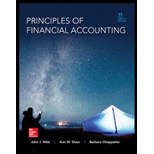
1 (a)
Prepare journal entries to record the purchase of
1 (a)
Explanation of Solution
Treasury stock: The shares which were reacquired or bought back by the company, but not formally retired from the corporation stock, are called as treasury stock. The re-acquisition of issued shares decreases the number of outstanding shares.
Prepare the
| Date | Account Titles | Debit ($) | Credit ($) |
| October 11 | Treasury Stock | 125,000 | |
| Cash | 125,000 | ||
| (To record purchase of treasury stock) |
Table (1)
To record purchase of treasury stock:
- Treasury stock is contra-stockholders’ contra equity account with a normal balance of debit. Thus, when treasury stocks are purchased, it decreases the
stockholders’ equity account. In this case, it reduces the stockholders’ equity. Therefore, treasury stock account is debited. - Cash is an asset account, and it decreases the value of cash account. Therefore, credit cash account.
1 (b)
Prepare journal entries to record the sale of treasury stock.
1 (b)
Explanation of Solution
Prepare the journal entry to record the sale of treasury shares:
| Date | Account Titles | Debit ($) | Credit ($) |
| November 1 | Cash | 31,000 | |
| Treasury Stock | 25,000 | ||
| Paid-In Capital, Treasury stock | 6,000 | ||
| (To record sale of treasury stock for above the cost price) |
Table (2)
- Cash is an asset account, and it increases the value of cash account. Therefore, debit cash account.
- Treasury stock is contra-stockholders’ contra equity account with a normal balance of debit. Thus, when treasury stocks are sold at its cost price, then cash would be debited and treasury stock would be credited. But, when treasury stocks are sold for higher than its cost price, then cash would be debited and treasury stock would be credited for cost price, and paid-in capital from treasury stock would be credited for excess selling price.
1 (c)
Prepare journal entries to record the sale of treasury stock.
1 (c)
Explanation of Solution
Prepare the journal entry to record the sale of treasury shares:
| Date | Account Titles and Explanation | Post Ref. | Debit ($) | Credit ($) |
|
November 25 | ||||
| Cash | 80,000 | |||
| Paid-in Capital–Treasury stock | 6,000 | |||
| 14,000 | ||||
| Treasury Stock | 100,000 | |||
| (To record sale of treasury stock) |
Table (3)
To record sale of treasury stock:
- Cash is asset account. The amount is increased because cash is received on sale of treasury stock. Therefore, debit Cash account.
- Paid-in Capital–Share Repurchase is a stockholders’ equity account and the amount has decreased because treasury stock is sold for lesser than the price purchased. Therefore, debit Paid-in Capital–Share Repurchase account.
- Retained Earnings is a stockholders’ equity account. The amount has decreased because treasury stock is sold for lesser than the price purchased. Therefore, debit Retained Earnings account.
- Treasury Stock is a stockholders’ equity account and the equity amount has increased due to sale of treasury stock. Therefore, credit Treasury Stock account.
2.
Explain the manner in which the company’s equity section changes after the October 11 treasury stock purchase, and prepare the revised equity section of its
2.
Explanation of Solution
Explain the manner in which the company’s equity section changes after the October 11 treasury stock purchase:
- There will be a change in the description line of the common stock account. After the purchase of treasury stock, common stock will be as follows:
| Common stock–$10 par value; 72,000 shares authorized and issued; 5,000 shares in treasury | $720,000 |
Table (4)
The dollar balance of this common stock account does not change with a treasury stock purchase.
- There will not be any change in the descriptions, and dollar amounts for Paid-In capital in excess of par value.
- There will be not be any change in the dollar balance of the retained earnings, but there will be a change in its description as follows:
| Retained earnings ($125,000 restricted for treasury stock) | $864,000 |
Table (5)
- Before the total line for stockholders’ equity, a deduction for the cost of treasury stock is reported immediately, after the purchase as follows:
| Less: Cost of treasury stock | $(125,000) |
Table (6)
- There will be change in stockholders’ equity from $1,800,000 to $1,675,000.
Prepare the revised equity section of its balance sheet:
| Particulars | Amounts ($) |
| Common stock–$10 par value; 72,000 shares authorized and issued; 5,000 shares in treasury | $720,000 |
| Paid-in capital in excess of par value, Common stock | 216,000 |
| Retained earnings, $125,000 restricted by treasury stock | 864,000 |
| Total | 1,800,000 |
| Less: Cost of treasury stock | (125,000) |
| Total stockholders’ equity | $1,675,000 |
Table (7)
Want to see more full solutions like this?
Chapter 13 Solutions
Principles of Financial Accounting.
- Can you help me solve this general accounting problem using the correct accounting process?arrow_forwardI need the correct answer to this general accounting problem using the standard accounting approach.arrow_forwardI need assistance with this general accounting question using appropriate principles.arrow_forward

 AccountingAccountingISBN:9781337272094Author:WARREN, Carl S., Reeve, James M., Duchac, Jonathan E.Publisher:Cengage Learning,
AccountingAccountingISBN:9781337272094Author:WARREN, Carl S., Reeve, James M., Duchac, Jonathan E.Publisher:Cengage Learning, Accounting Information SystemsAccountingISBN:9781337619202Author:Hall, James A.Publisher:Cengage Learning,
Accounting Information SystemsAccountingISBN:9781337619202Author:Hall, James A.Publisher:Cengage Learning, Horngren's Cost Accounting: A Managerial Emphasis...AccountingISBN:9780134475585Author:Srikant M. Datar, Madhav V. RajanPublisher:PEARSON
Horngren's Cost Accounting: A Managerial Emphasis...AccountingISBN:9780134475585Author:Srikant M. Datar, Madhav V. RajanPublisher:PEARSON Intermediate AccountingAccountingISBN:9781259722660Author:J. David Spiceland, Mark W. Nelson, Wayne M ThomasPublisher:McGraw-Hill Education
Intermediate AccountingAccountingISBN:9781259722660Author:J. David Spiceland, Mark W. Nelson, Wayne M ThomasPublisher:McGraw-Hill Education Financial and Managerial AccountingAccountingISBN:9781259726705Author:John J Wild, Ken W. Shaw, Barbara Chiappetta Fundamental Accounting PrinciplesPublisher:McGraw-Hill Education
Financial and Managerial AccountingAccountingISBN:9781259726705Author:John J Wild, Ken W. Shaw, Barbara Chiappetta Fundamental Accounting PrinciplesPublisher:McGraw-Hill Education





